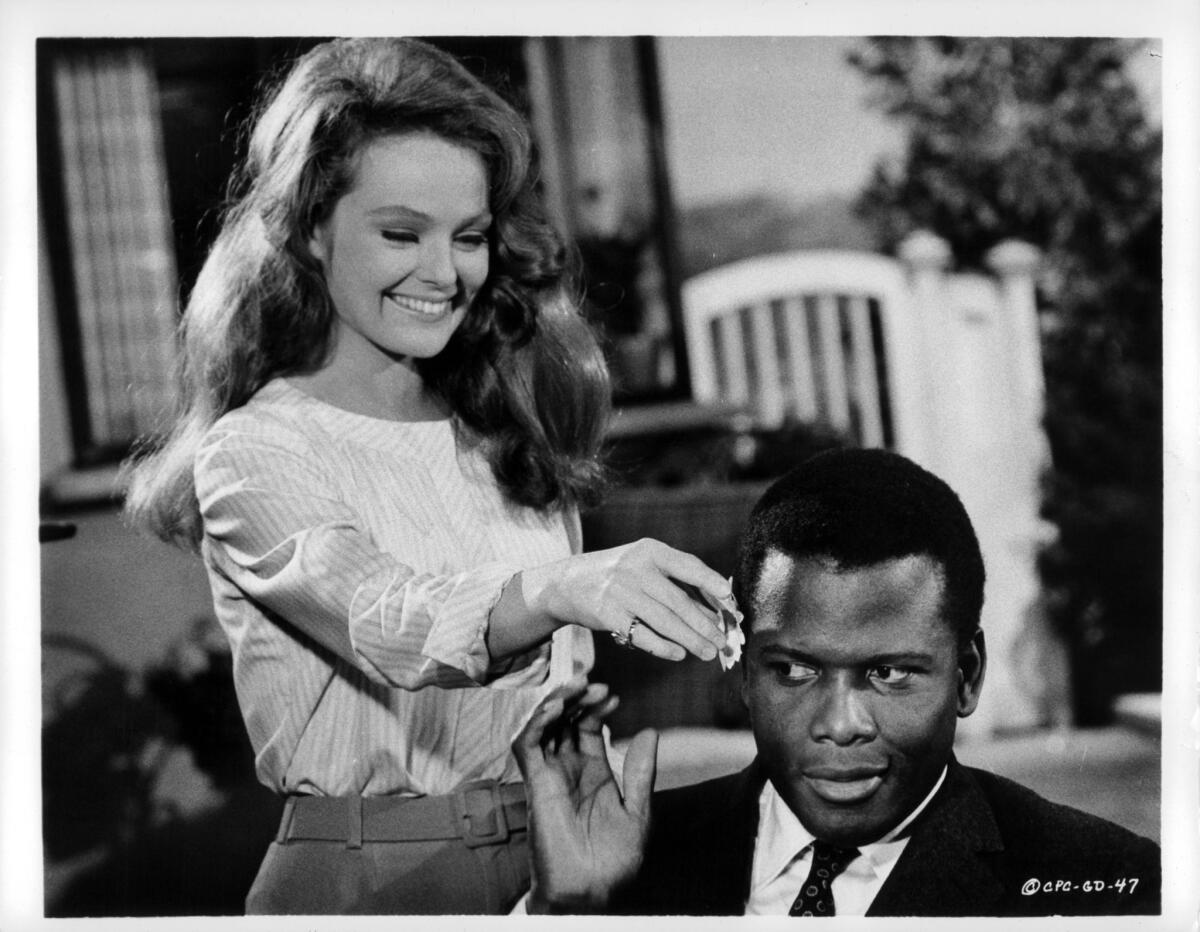‘Guess Who’s Coming to Dinner’ is 50 and racial tension still a problem in America
Even 50 years ago, in a nation inflamed by prejudice and civil rights marches, the interracial marriage fable “Guess Who’s Coming to Dinner” played suave and polite at a defining moment when cinema was shifting from studio conventionality to bracing realism.
Directed by Stanley Kramer, the film was a mannered Hollywood take on an incendiary topic. Some critics found it bland and patronizing, but it was a commercial hit that epitomized mainstream Hollywood’s liberal leanings at a time when more revolutionary films about social upheaval, such as “The Graduate” and “Bonnie and Clyde,” were recasting American sensibilities.
Kramer was known for his socially conscious if orthodox movies, including “Inherit the Wind” and “Judgment at Nuremberg.” “Guess” fit his political and narrative instincts. It was released the year the Supreme Court struck down laws in more than a dozen states that banned mixed-race marriages. The film — along with the interracial police drama “In the Heat of the Night” — opened in an era of unrest that would lead months later to the assassination of Martin Luther King Jr. and nationwide race riots.
Both films were nominated for a best picture Oscar and starred Sidney Poitier, an urbane black actor bankable with white audiences. That allure was heightened in “Guess” by the two other leads, Katharine Hepburn and Spencer Tracy, who gave the film the imprimatur of Hollywood royalty. It was like slipping a revolution into an evening glove.
“Guess” underlined Kramer’s belief to teach “people to think outside the box, to be daring,” said Gil Robertson, president of the African American Film Critics Assn. who wrote the introduction to the film’s 50th anniversary Blu-ray Digibook released this month. “I don’t know if it carries the same weight it did. But it does carry a strong message.”

Kramer challenged Southern white audiences early in the film with a kiss between John Prentice (Poitier), a Yale-educated doctor and humanitarian, and his white fiancee, Joey Drayton (Katharine Houghton). Kramer and Houghton received death threats after the film’s release. But the movie tested and was cushioned by the ideals of the white, liberal elite. Drayton’s parents, Matt (Tracy), a newspaper publisher, and Christina (Hepburn), an art dealer, lived high in the San Francisco hills.
Race in America today remains confounding and dangerous. Discrimination and schisms have led to the shootings of African American men by police, the rise of the Black Lives Matter movement, identity politics and a new president who has been criticized for drawing lines between races and whose Supreme Court nominees might threaten gay marriage and LGBT rights. The themes in “Guess” have since broadened to other ethnicities and life styles, revealing at once the nation’s diversity and the backlash against it.
Civil rights and racial narratives are explored in smart TV shows like “black-ish” and “This Is Us”; the biting films of Spike Lee; Barry Jenkins’ “Moonlight” and Ava DuVernay’s “13”, both nominated for Academy Awards; and “Loving,” the current biopic about Richard and Mildred Loving, the interracial Virginia couple whose Supreme Court case struck down laws against mixed marriages. Much more so than “Guess,” which opened months after the case was decided, “Loving” depicts the peril interracial couples faced half a century ago.
Kramer’s movie, which earned 10 Academy Award nominations, is also looked on with nostalgia for one of cinema’s most potent duos. Tracy died shortly after filming what was his last of nine collaborations with Hepburn, who won an Oscar for her performance. The couple’s on- and off-screen romance was legendary, and Tracy’s soliloquy in “Guess,” whose script was written by William Rose, played as a personal love letter to Hepburn.
The New York Times called the film “a most delightfully acted and gracefully entertaining film.” Some critics found it contrived and behind the times, while others suggested Poitier’s character was too perfect; James Baldwin noted that Dr. Prentice placated white liberals but skewed reality for blacks. Los Angeles Times critic Charles Champlin praised the movie overall but added: “The nagging uneasiness is that the [racial] problem has not really been confronted or solved, but only patronized.”
It was really an influential film for me growing up. There were so few representations of black people living as fully dimensional in a white culture.
— Dawn Porter, African American filmmaker
Richard Schickel’s review in Life magazine was more blunt: “Where to begin discussing the ineptitude with which the nightmare is realized on screen. … Kramer is earnestly preaching away on matters that have long since ceased to be true issues.”
That wasn’t so for many Americans. “It was really an influential film for me growing up,” said Dawn Porter, a black director who made the civil rights documentary “Spies of Mississippi” and is working on a film about Bobby Kennedy. “There were so few representations of black people living as fully dimensional in a white culture. Poitier was at dinner. He was a man, not a sidekick. He was elegant and happy. It was an important cultural touchstone.”
“Guess” arrived at a time of dramatic shift in cinema as maverick filmmakers pushed beyond the bounds of Hollywood convention symbolized in the movies of Tracy and Hepburn. The Academy Award nominees for best film were: “Guess,” “In the Heat of the Night,” “Dr. Dolittle” — each falling within the Hollywood mainstream — and “The Graduate” and “Bonnie and Clyde,” two films that spoke to the anxieties and aesthetics of a restless, disillusioned young generation moving away from the political and social constraints of their parents.
“It was increasingly clear that something was dying and something was being created, but the transition between old and new is never elegant or seamless,” wrote Mark Harris in “Pictures at a Revolution: Five Movies and the Birth of the New Hollywood.” “The old and the new existed in uneasy proximity, eyeing each other across a red-carpeted aisle that was becoming easy to mistake for a battle line.”
Perhaps it was fitting that “Heat,” grittier than “Guess” but not as searing or bold as “Bonnie and Clyde,” won best picture.
“Guess” was a testament to Kramer’s world view and his use of comedy to navigate a controversial topic. His other works included “Inherit the Wind,” a fictional account of the 1925 Scopes Monkey Trial on evolution, “Judgment at Nuremberg,” about Nazi atrocities, and “The Defiant Ones,” the saga of two inmates — one black, one white — who escape prison but are chained together. “Inherit” starred Tracy and “Defiant” starred Poitier.
“The message Stanley wanted was that it was inhumane that people weren’t allowed to get married,” said actress and Kramer’s widow, Karen Sharpe-Kramer. “He didn’t think any one film would change anybody’s mind completely. But it could get them to think about it.” She added that while making the movie “we were right at the crest of change.”
That same year the white daughter of U.S. Secretary of State Dean Rusk married a black Stanford University student. Other movies, including MGM’s “A Patch of Blue” (1965), which also starred Poitier, had already addressed interracial relationships, but Columbia Pictures worried about financial losses if the film didn’t play well in Southern states. There were other complications too. Tracy’s deteriorating health made made him uninsurable and a liability. To allay the studio’s unease, Kramer and Hepburn put their salaries in escrow to cover costs if Tracy couldn’t finish filming.
Columbia overcame its reservations and the picture, which had a budget of about $4 million, has since grossed more than $56 million. “We all felt they [Columbia] were afraid of the subject matter and afraid of losing money,” said Sharpe-Kramer. “Stanley understood this. It’s called show ‘business’ after all. … But they had to go through with the movie.” Harris’ book suggests that Columbia was more concerned with Tracy’s health than the racial story line.
“I think the film stands up great today. It has heart and tells a certain part of our history,” said Sharpe-Kramer. “Race is not the hot-button issue it was in 1967. That’s changed. But we still have many, many problems.”
Twitter: @JeffreyLAT
More to Read
Only good movies
Get the Indie Focus newsletter, Mark Olsen's weekly guide to the world of cinema.
You may occasionally receive promotional content from the Los Angeles Times.








